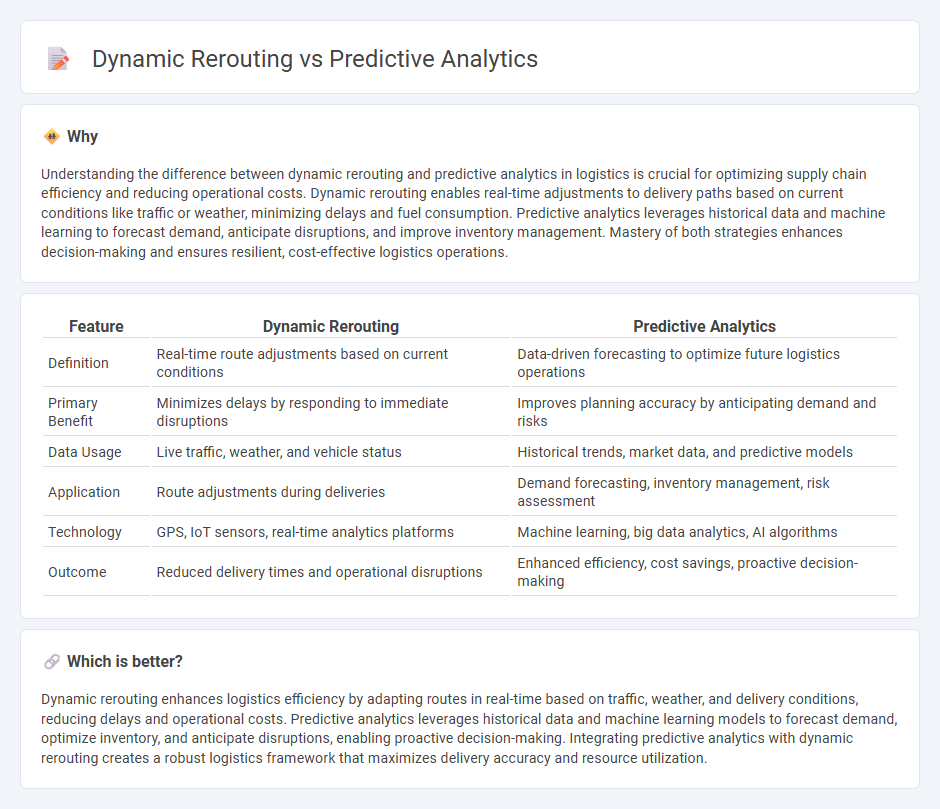
Dynamic rerouting in logistics leverages real-time data to adjust delivery paths instantly, minimizing delays caused by congestion, accidents, or weather disruptions. Predictive analytics uses historical data and machine learning algorithms to forecast demand patterns and potential delivery challenges, enabling proactive route optimization. Explore the differences and benefits of dynamic rerouting and predictive analytics to enhance your logistics strategy.
Why it is important
Understanding the difference between dynamic rerouting and predictive analytics in logistics is crucial for optimizing supply chain efficiency and reducing operational costs. Dynamic rerouting enables real-time adjustments to delivery paths based on current conditions like traffic or weather, minimizing delays and fuel consumption. Predictive analytics leverages historical data and machine learning to forecast demand, anticipate disruptions, and improve inventory management. Mastery of both strategies enhances decision-making and ensures resilient, cost-effective logistics operations.
Comparison Table
| Feature | Dynamic Rerouting | Predictive Analytics |
|---|---|---|
| Definition | Real-time route adjustments based on current conditions | Data-driven forecasting to optimize future logistics operations |
| Primary Benefit | Minimizes delays by responding to immediate disruptions | Improves planning accuracy by anticipating demand and risks |
| Data Usage | Live traffic, weather, and vehicle status | Historical trends, market data, and predictive models |
| Application | Route adjustments during deliveries | Demand forecasting, inventory management, risk assessment |
| Technology | GPS, IoT sensors, real-time analytics platforms | Machine learning, big data analytics, AI algorithms |
| Outcome | Reduced delivery times and operational disruptions | Enhanced efficiency, cost savings, proactive decision-making |
Which is better?
Dynamic rerouting enhances logistics efficiency by adapting routes in real-time based on traffic, weather, and delivery conditions, reducing delays and operational costs. Predictive analytics leverages historical data and machine learning models to forecast demand, optimize inventory, and anticipate disruptions, enabling proactive decision-making. Integrating predictive analytics with dynamic rerouting creates a robust logistics framework that maximizes delivery accuracy and resource utilization.
Connection
Dynamic rerouting in logistics leverages predictive analytics to anticipate disruptions and optimize delivery routes in real-time, enhancing operational efficiency. Predictive models analyze historical and real-time data such as traffic patterns, weather conditions, and shipment status to suggest alternative paths before delays occur. This integration reduces transit times, lowers costs, and improves customer satisfaction by ensuring timely deliveries.
Key Terms
Forecasting demand (predictive analytics)
Forecasting demand in predictive analytics leverages historical data, machine learning algorithms, and statistical models to anticipate future customer needs and optimize resource allocation. Unlike dynamic rerouting, which reacts to real-time disruptions, demand forecasting enables proactive planning by predicting sales trends and inventory requirements accurately. Explore more to understand how forecasting demand transforms operations across industries.
Real-time traffic data (dynamic rerouting)
Real-time traffic data powers dynamic rerouting by continuously analyzing current road conditions, congestion, and incidents to optimize route selection instantly. Predictive analytics uses historical traffic patterns and machine learning models to forecast future traffic trends, enabling proactive route planning. Explore how integrating both approaches enhances transportation efficiency and reduces travel time.
Route optimization algorithms
Route optimization algorithms leverage predictive analytics to forecast traffic patterns, delivery times, and potential delays, enhancing decision-making for efficient routing. Dynamic rerouting algorithms adapt in real-time to changing conditions such as traffic congestion, accidents, or weather, ensuring continuous optimization of routes based on live data. Explore how integrating predictive analytics with dynamic rerouting can significantly improve route efficiency and delivery precision.
Source and External Links
What is Predictive Analytics? | IBM - Predictive analytics uses historical data combined with statistical modeling, machine learning, and data mining to predict future outcomes, assess risks, and find opportunities.
What is predictive analytics and how does it work? | Google Cloud - Predictive analytics forecasts future outcomes by analyzing data with machine learning, AI, and statistical models, helping organizations predict trends with high precision.
A Guide To Predictive Analytics - Tableau - Predictive analytics applies data mining, statistics, and AI to interpret historical data and predict the likelihood of future events to help businesses be proactive.
 dowidth.com
dowidth.com